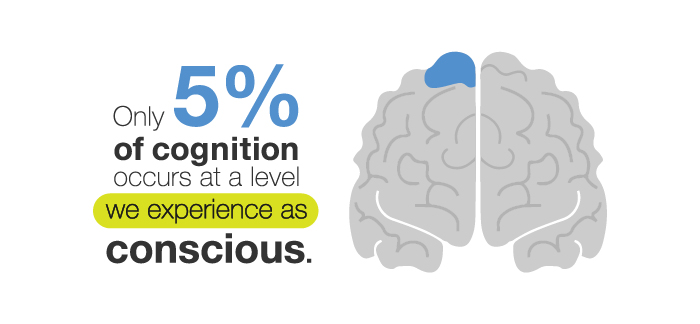The tumor appeared near the front of Elliot’s brain, crowding a region called the ventromedial frontal lobe. When doctors removed it, his life fell to pieces.
Following his surgery, Elliot’s once-successful career plummeted, jeopardized by inexplicable errors of judgment. He eventually lost his job and was unable to find another. His happy marriage disintegrated, as did his other personal relationships. He seemed incapable of making healthy choices and witnessed his life devolve rapidly as a result.
Although the tumor’s effects were clearly significant, its destruction was curiously selective. Despite his ever-worsening circumstances, Elliot’s intelligence had remained virtually unchanged. Rather, his illness had ravaged a more fundamental aspect of his capacity to make decisions: his emotional mind.
Observing Elliot, the neuroscientist Antonio Damasio wrote, “The tragedy of this otherwise healthy and intelligent man was that he was neither stupid nor ignorant, and yet he acted often as if he were. The machinery for his decision-making was so flawed that he could no longer be an effective social being.”
Why Brands Should Care About the Brain
Damasio’s turn of phrase, “the machinery of decision-making,” should have the ring of relevance for marketers. After all, brands are largely at the mercy of this machinery and its consequences for their customers.
Notice the distinction embedded in Damasio’s assessment: Intelligence and decision-making ability are separate entities. Elliot possessed plenty of cognitive aptitudes, but no framework to appraise his options. Ironically, many brands attempt to persuade consumers as if they all shared his condition.
How often do companies sell their wares in purely rational terms, hoping to convince through calculation? “Lasts three times longer!” “Now 20 percent more, for free!” These are appeals to our intellect, expressing basic principles of tangible value.
But Elliot’s experience suggests these messages miss the part of the mind that really conducts the evaluation. Despite these numbers and noise, the emotional machinery of our decision-making rumbles on, undisturbed.
This is the news that neuroscience brings to marketers: Consumers are human, and the human mind’s complexity can’t be ignored. Over nearly two decades of intensive research, Brandtrust has contributed to the nascent field of neuromarketing, the union of these disciplines. As a result, we’ve learned how surprising the brain’s functioning can be, and how indispensable neuroscience knowledge is to actually understanding customers.
Below, we’ll discuss some core principles of neuromarketing that every effective brand strategy must acknowledge and incorporate. With these essential insights in hand, marketers can move away from ineffective promotion and toward true persuasion.
Facts Instead of Figures
Evaluation Is Emotional
Recall the particular region that was damaged in Elliot’s brain: the ventromedial frontal lobe. In a recent study, researchers at the University of Pennsylvania studied the VMF through functional MRI imaging as participants considered the relative value of various food commodities.
Their findings confirmed what Damasio suggested: Those with healthy VMFs made more accurate and consistent assessments. But those with impaired VMF function didn’t lack logical aptitude. Rather, neuroscientists say they suffered from “emotional dysregulation.” So why exactly is a primarily emotional region of the brain so integral to the way we make choices?
The answer may lie in the complex web of rational and emotional subsystems our brain employs to survive. While we often imagine ourselves as rational creatures, dispassionately assessing our options, we reach decisions through a rich interplay of logical brain functions and instinctive emotional systems.
However, this process cannot begin without a spark in the limbic region, the nexus of our most basic and powerful feelings, such as attraction and fear. This system has its survival benefits: Cross paths with a predator and fight or flight better come first. But it’s only after this emotional impetus that our rational capacities kick into gear no matter the context.
In other words, marketers who prioritize rational appeals to woo consumers are starting in the wrong place altogether.
Takeaway: Focus less on figures and more on feelings. They’re the true currency of consumer choice.
Emotions Are Associations
If emotions drive consumer decisions, then how are specific feelings formed? Most of us believe (correctly) that feelings are informed by relevant experiences – affection for a friend develops over time spent together, or distrust occurs when someone lets you down. When we draw such experiences to mind, we call them memories.
However, most of us have misunderstood the way memory and feelings function, both independently and in relation to each other. Generally, we conceive of our memories as comparable to video archives – full of pristinely preserved recollections, readily accessible when needed. In reality, our recall depends on more fluid amalgams of experiential information.
As author Israel Rosenfield notes, our memories are constantly shifting to incorporate new data, adjusting our repositories of prior experiences. Our associations with horses, for instance, are a messy combination of all our interactions with them, rather than a series of discrete recollections. Scientists call these “engrams,” or neuronal pathways modified by our experiences.
These frameworks then inform our emotional responses to each piece of the world around us. In fact, pattern recognition trumps individual data points in virtually every facet of human calculation – we simply can’t process all the facts life throws at us, so we rely on associative shortcuts instead. This realization has powerful implications for brands interacting with their customers.
If you deliver mediocrity or even disappointment repeatedly, don’t expect to turn the tide of customer feeling with an isolated gesture, such as offering an excellent discount. By the same token, if you consistently succeed in honoring what matters most to customers, they’re unlikely to attach much significance to your rare errors.
Takeaway: What kind of associations is your brand currently accumulating? Pay attention to customers’ pain points, or they could come to dominate their perception of your brand.
Trust Matters Most
While the positive associations we attach to beloved brands may vary greatly by category, our research suggests they possess one constant: the trust of their customers. Given the crucial function of trust in human relationships, it’s not hard to see why.
Trust may be essential to all our mutually beneficial interactions today (friendship, romance, professional ties), but it carried even higher stakes in our evolutionary history. In early human communities, it was often difficult to discern if our neighbors intended to cooperate or kill. As a result, trust and suspicion were essential features of our adaptive progress, hardwired into our decision cognition.
Researchers have observed the effects of trust at this chemical level, correlating the emotion with increased levels of oxytocin in the brain. This very compound is sometimes called the “emotional umbilical cord,” because it occurs when babies interact with their mothers. When adults experience trust of another person, the same chemical results.
As in our personal relationships, consistency and benevolent intentions form the basis of trust in a brand. When a company’s service is unpredictable, or employees seem likely to cut corners at the customer’s expense, we apply a suspicious framework to all our subsequent experiences.
But when a brand demonstrates the intention to deliver for customers and the ability to consistently do so, we begin to trust them as we do the people we count on. We may even part with more money due to our loyalty. One study found that when participants experienced elevated oxytocin levels, their “monetary sacrifices” increased 243 percent. In other words, people will put a pretty high price on trust.
Takeaway: Establish values that put the consumer first, and then execute them consistently. There’s no greater brand asset than earned trust.
The Customer Is Often Wrong
One might assume that traditional market research strategies can also supply the insights neuromarketing promises. While we might not understand the neurological processes behind customer decisions, traditional research methods will tell us what they want, right?
Wrong. Unfortunately, the brain’s greatest limitation may be its inability to observe its own functions accurately. Because only 5 percent of cognition occurs at a level we experience as conscious, the vast majority of what the mind does is inaccessible to us.
This dynamic is a matter of necessity: Nonconscious processes permit us to receive and respond to millions of data points each day. If we had to rationally evaluate each item of information in our environment, we’d be paralyzed by the sheer amount of processing required.
But another quirk of the mind makes customer feedback even more dubious: We’re excellent at inventing justifications for our actions retroactively. In fact, we usually believe these explanations about our own nonconscious choices, whether they’re real or not.
Pioneering psychologist Michael Gazzaniga associates this phenomenon with the left hemisphere of our brains. This region functions as the “interpreter,” crafting narratives that present automatic actions in terms of logical choice. “Working on the fly, it furiously reconstructs not only what happened but why, inserting motives here, intentions there – based on limited, sometimes flawed information,” Gazzaniga writes.
In other words, relying too heavily on customer feedback is a dangerous business. They may give you bad information and not even know it.
Takeaway: Forget traditional means of gauging consumer sentiment. Instead, adopt psychological techniques that assess deep motives more accurately.
Neuromarketing: The Next Step
Although these findings are a basis for transforming your branding strategy, there’s no simple solution to the complexity of your customers’ minds. In fact, long before they are applied, these concepts must be thoughtfully unpacked in light of each brand’s circumstances.
For nearly two decades, the Brandtrust team has guided the world’s most respected brands through this endeavor. Leveraging research methodologies developed in social science disciplines, we study the minds and motives of target audiences. As a result, we equip marketers with insights both deep and actionable, so they can engage customers with new confidence. If you’re eager to apply the learnings of neuroscience and consumer psychology to your own brand work, our processes are designed to aid you in that effort.
To find out more about our mission and methodologies, explore our work with many of the world’s largest brands.


